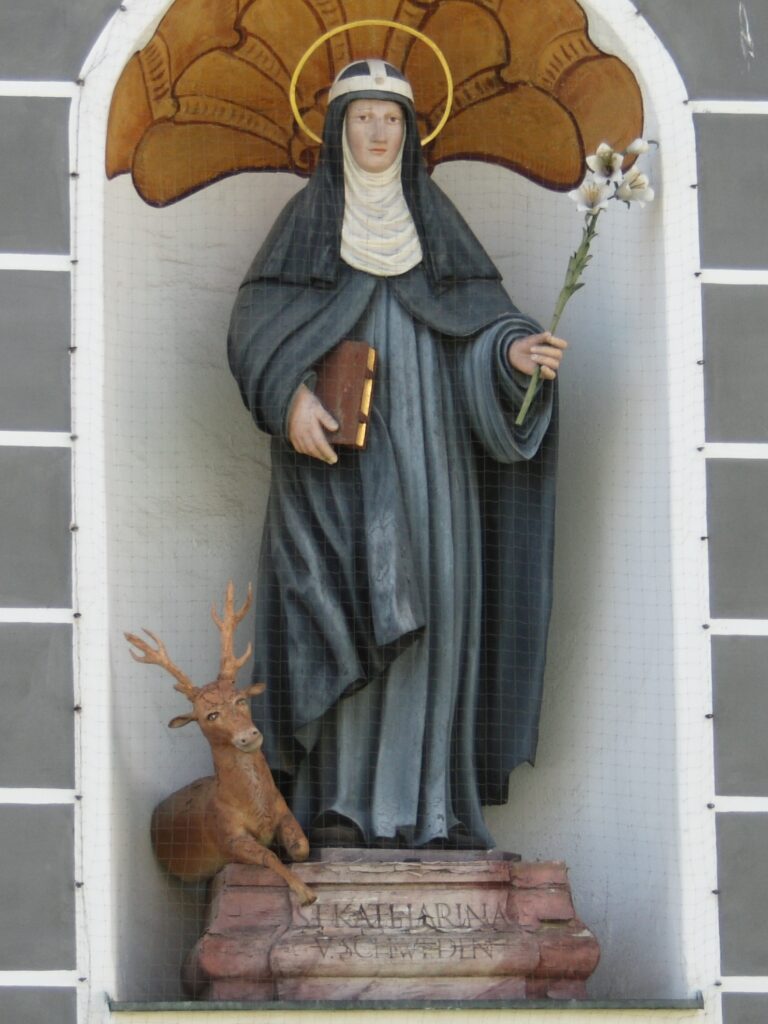By Julian Pace

Through a life of prayer, piety and asceticism, St Catherine of Sweden gave herself to God entirely. She had no regard for temporal desires. Born in 1331 in Sweden, she was the fourth of eight children of her father, nobleman Ulf Gudmarsson and her mother, St Bridget. Her mother was the founder of the Order of the Most Holy Saviour.
At the age of seven, St Catherine of Sweden was sent to the convent of Risburgh, where she received her spiritual formation as well as an education under the care and guidance of the holy abbess of that house.
At the age of thirteen, her father arranged for her to marry a German nobleman by the name of Eggart von Kürnen, who himself was a man of great virtue. So much so that on the night of their wedding, the couple took a vow of perpetual chastity. Further to their vow of chastity, St Catherine had a considerable impact on the spiritual life of her husband, who because of her discourses ended up seeking only the desire of heavenly graces and a pure soul.
The short marriage of St Catherine of Sweden to Eggart saw the couple perform several acts of mortification and charity. Following the death of her father, St Catherine accompanied her mother on a pilgrimage to Rome in 1349 to visit the relics of the Roman Martyrs. This was just one of many of her practices of penance and devotion to the passion of Christ.
News of the death of her husband reached her while in Rome, leaving St Catherine a widow before she even turned twenty. Despite this, she refused many offers of marriage, instead choosing to live the next twenty-five years of her life in Rome with her mother, St Bridget in assisting the poor. In addition to this, she accompanied her mother on various pilgrimages, including one to the Holy Land.
Following the death of her mother in 1373, St Catherine accompanied the remains back to Sweden, where in 1374, she buried her at the convent of the Order of the Holy Saviour in Vadzstena. St Catherine then assumed the role of the Superior of this Order, which as mentioned above was founded by her mother. St Catherine managed the Order with great care, guaranteeing that life at the convent was according to the principles outlined by her mother.
St Catherine also continued her charity to the poor and wrote a devotional work entitled “Sielinna Troëst” or Consolation of the Soul. In 1375, St Catherine returned to Rome to pursue the canonisation of her mother as well as to obtain a new Papal confirmation for the Order of the Most Holy Saviour, succeeding in the latter after obtaining confirmations from Pope Gregory XI in 1377 and from Pope Urban VI 1379. However, the canonization of her mother was delayed to 1391 because of the Great Schism in 1378.
St Catherine testified on behalf of Pope Urban XI against the Antipope Clement VII in front of a judicial commission. It was during this period of her life in Rome that St Catherine of Sweden met and formed a deep friendship with St Catherine of Siena, one of the doctors of the Roman Catholic Church.
In 1380, St Catherine returned to Sweden in possession of a formal letter of commendation from Pope Urban VI. She then became abbess of Vadzstena and would spend the final year of her life in that role. On the 24th of March 1381, St Catherine of Sweden passed away after a period of ill health, she spent the last twenty-five years of her life purifying her soul daily through the sacrament of confession.
In 1484, Pope Innocent VII confirmed the veneration of St Catherine of Sweden as a Saint and her feast is celebrated on the 22nd of March, with her relics being translated to Vadzstena in 1488. However, the Protestant revolution interrupted her canonization process.
Today, St Catherine of Sweden’s legacy lives on as the Patron Saint for women suffering miscarriages and against Abortion. In Christian iconography there are various depictions of her as a Brigittine holding a lily, a Brigittine tending to a poor man’s wounds and as a Brigittine being brought Communion on her deathbed.
User:GFreihalter / Crop by José Luiz, CC BY-SA 3.0 https://creativecommons.org/licenses/by-sa/3.0, via Wikimedia Commons
This year, it is more crucial than ever that we turn to prayer and intercession to increase devotion to Our Lady across our country. That’s why you’re invited to join us in the Three Hail Marys Pledge, a powerful devotion that can bring personal spiritual benefits and national transformation. By reciting three Hail Marys daily, you honour the Immaculate Heart of Mary and seek her intercession for the conversion of sinners, the salvation of souls and the restoration of Ireland’s Catholic Faith. This ancient devotion, revealed to Saint Mechtilde, promises spiritual benefits including protection from mortal sin and the assurance of a good death. Your daily prayers will contribute to an increase in devotion to Our Lady, the conversion of sinners and the moral renewal of our country. Let us commit to this powerful devotion and seek the guidance and protection of Our Lady.

Leave a Reply to Joe Cancel reply